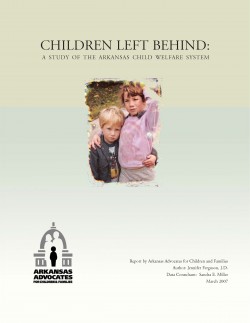
The performance of the Arkansas Child Welfare System declined significantly beginning in 2004, as measured by a broad range of indicators related to protecting children from abuse and neglect and providing services to help children and families. The decline corresponded with a severe shortage of family service workers at the Division of Children and Family Services (DCFS). In 2005, the vacancy rate among all family service worker positions reached a high of 23%, up from 10% in 2002.
Some of the more troubling indicators identified in the July 2006 report by Arkansas Advocates for Children and Families (AACF) on the child welfare system (data from January 2005 to March 2006) included3:
- Only 68% of child victims were seen by an investigator within the required 72 hours of the initial call. In 2000, this figure was 89%.
- Only 47% of maltreatment assessments were concluded within the required 30 days after an allegation of maltreatment, down from 80% in 2000.
- Only 29% of cases had an initial staffing held within the required 30 days to develop a case plan with the family to identify a goal, needs, and services.
- Only 44% of foster children received monthly visits from caseworkers as required.
Given these significant problems, the question arose as to whether children who fall within certain demographic groups may be even more at risk of receiving inadequate care. AACF was awarded a one year grant from the Winthrop Rockefeller Foundation in December 2005 to conduct a study of whether disparities existed in how children were treated in the child welfare system based on age, gender, race, ethnicity, and geographic location. The following report details:
- how the study was conducted,
- the findings,
- the challenges encountered during the study, and
- recommendations for future studies.
